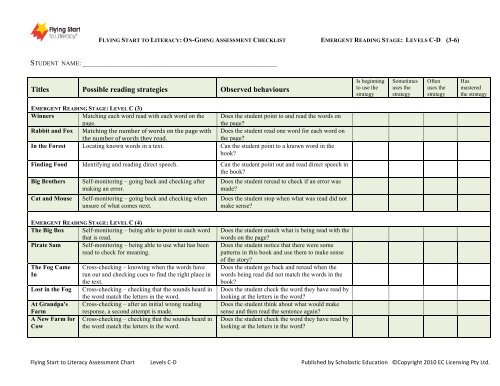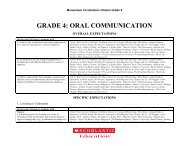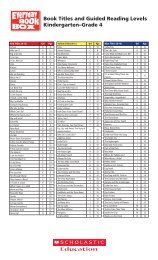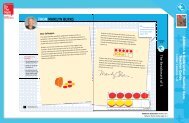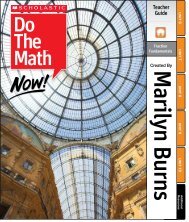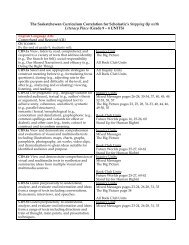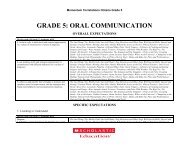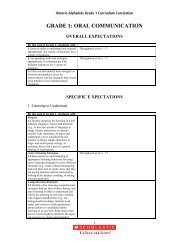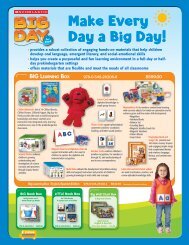Titles Possible reading strategies Observed behaviours
Levels CâD Emergent Stage - Scholastic Education
Levels CâD Emergent Stage - Scholastic Education
You also want an ePaper? Increase the reach of your titles
YUMPU automatically turns print PDFs into web optimized ePapers that Google loves.
FLYING START TO LITERACY: ON-GOING ASSESSMENT CHECKLIST EMERGENT READING STAGE: LEVELS C-D (3-6)STUDENT NAME: ________________________________________________________<strong>Titles</strong> <strong>Possible</strong> <strong>reading</strong> <strong>strategies</strong> <strong>Observed</strong> <strong>behaviours</strong>Is beginningto use thestrategySometimesuses thestrategyOftenuses thestrategyHasmasteredthe strategyEMERGENT READING STAGE: LEVEL C (3)Winners Matching each word read with each word on thepage.Does the student point to and read the words onthe page?Rabbit and Fox Matching the number of words on the page with the number of words they read. Does the student read one word for each word onthe page?In the Forest Locating known words in a text. Can the student point to a known word in thebook?Finding Food Identifying and <strong>reading</strong> direct speech. Can the student point out and read direct speech inthe book?Big BrothersCat and MouseSelf-monitoring – going back and checking aftermaking an error.Self-monitoring – going back and checking whenunsure of what comes next.Does the student reread to check if an error wasmade?Does the student stop when what was read did notmake sense?EMERGENT READING STAGE: LEVEL C (4)The Big Box Self-monitoring – being able to point to each wordthat is read.Pirate Sam Self-monitoring – being able to use what has beenread to check for meaning.The Fog CameInLost in the FogAt Grandpa'sFarmA New Farm forCowCross-checking – knowing when the words haverun out and checking cues to find the right place inthe text.Cross-checking – checking that the sounds heard inthe word match the letters in the word.Cross-checking – after an initial wrong <strong>reading</strong>response, a second attempt is made.Cross-checking – checking that the sounds heard inthe word match the letters in the word.Does the student match what is being read with thewords on the page?Does the student notice that there were somepatterns in this book and use them to make senseof the story?Does the student go back and reread when thewords being read did not match the words in thebook?Does the student check the word they have read bylooking at the letters in the word?Does the student think about what would makesense and then read the sentence again?Does the student check the word they have read bylooking at the letters in the word?Flying Start to Literacy Assessment Chart Levels C-‐D Published by Scholastic Education ©Copyright 2010 EC Licensing Pty Ltd.
FLYING START TO LITERACY: ON-GOING ASSESSMENT CHECKLIST EMERGENT READING STAGE: LEVELS C-D (3-6)STUDENT NAME: ________________________________________________________<strong>Titles</strong> <strong>Possible</strong> <strong>reading</strong> <strong>strategies</strong> <strong>Observed</strong> <strong>behaviours</strong>Is beginningto use thestrategySometimesuses thestrategyOftenuses thestrategyHasmasteredthe strategyEMERGENT READING STAGE: LEVEL D (5)Ant Nests Cross-checking – after making an error thereader is able to check one cue againstanother.Where Is My Cross-checking – checking that a wordNest?looks right.Lots of Legs Searching the text for syntactic cues –language structure.The Best LegsMy CampJournalA Monkey inthe CampCross-checking – making sure that theword sounds right.Cross-checking – checking that a wordlooks right.Searching for cues in the text – usingmeaning cues.Does the student check what is being read?Does the student think about what made sense whenchecking to see if the words being read had the rightletters?Does the student know to make their <strong>reading</strong> sound right?Does the student make sure that what was read soundsright?Does the student think about what made sense whenchecking to see if the words being read had the rightletters?Did the student make sure that what was being read madesense?EMERGENT READING STAGE: LEVEL D (6)What Am I? Searching – after an error has beenidentified, the reader tries to work out whathas gone wrong.Tad Grows Up Searching – re<strong>reading</strong> a passage andthinking about what would make sense.SpidersSearching – when an error is perceived, thereader searches the page and reads again,asking themselves would make sense.Does the student search the words in the text and thephotographs to help correct errors?Does the student pause and search in the pictures and text?Does the student notice when a mistake was made, rereadthe sentence, and use different cues to think about whatwould make sense?A Good Trap Searching for medial sounds. Does the student correct a word after paying attention tothe middle letters in a word? (changing “trip” to “trap”)On the MoveSelf-correcting – finding an error andcorrecting when prompted.Can the student correct errors when prompted?Grandpa's Car Self-correcting independently. Does the student correct errors made without prompting?Flying Start to Literacy Assessment Chart Levels C-‐D Published by Scholastic Education ©Copyright 2010 EC Licensing Pty Ltd.


